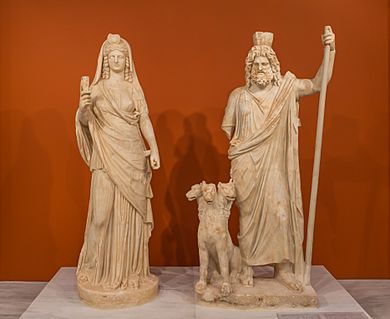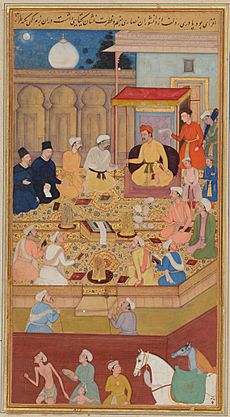Syncretism facts for kids
Syncretism is when you combine different beliefs or ideas. It's like mixing several traditions that were once separate. This often happens in religion, where different gods or stories are blended. Syncretism helps show that different faiths might have similar ideas. It also appears in art and culture, which is called eclecticism. In politics, it's known as syncretic politics.
Contents
What Does Syncretism Mean?
The word "syncretism" first appeared in English in the early 1600s. It comes from a Latin word, syncretismus. This word was inspired by an old Greek story. The story was about the people of Crete. They used to argue a lot. But when they faced danger from outside, they would put their differences aside. They would come together and work as one. This was called their "Syncretism," meaning "Union of Cretans."
A more likely origin for the word is from Greek words meaning "with" and "mix." So, syncretism is truly about "mixing together."
How Syncretism Works in Society

Sometimes, people openly mix beliefs from different cultures. This shows that they accept other traditions. For example, some people in Spain, called conversos, secretly kept parts of their old beliefs. They did this even while following Catholicism after the Spanish Inquisition.
The Kushite kings ruled Egypt for many years. They combined their god Dedun with the Egyptian god Osiris. They continued to worship this new mixed god even after they left Egypt. A temple for this god was found at Jebel Barkal.
Syncretism was very common during the Hellenistic period. This was a time after Alexander the Great. Rulers would often connect their local gods with Greek gods. This helped to unite their kingdoms. Most people accepted this idea. However, the Jews strongly disagreed. They believed their God, Yahweh, should not be mixed with the Greek god Zeus. They saw this as a great insult.
The Roman Empire also continued this practice. First, they mixed their Roman gods with Greek gods. This created a single Greco-Roman pantheon (group of gods). Then, they connected these gods with local gods in different Roman areas. Some people believe that many features of the goddess Isis were later given to the Christian Virgin Mary. Isis was widely worshipped in the later Roman Empire.
Some religious groups have openly embraced syncretism. For example, Shintō beliefs were blended into Buddhism in Japan. Also, Germanic and Celtic pagan ideas mixed with Christianity as it spread. Later, Christian missionaries in North America connected Manitou with the Christian God. Manitou is a spiritual force in the beliefs of the Algonquian people.
In Trinidad, Shi'i Islam shows some influences from India. However, some religions strongly reject syncretism. They believe it weakens their original beliefs. Examples include Second Temple Judaism, Islam, and most Protestant Christianity.
Syncretism can help different cultures and beliefs live together peacefully. This is why rulers of large empires often liked it. On the other hand, rejecting syncretism can help a group keep its unique cultural identity.
Religious Syncretism

Religious syncretism is when two or more religious belief systems combine. This can create a new system. Or, it can mean that beliefs from other traditions are added to an existing religion. This happens for many reasons. It is common where different religions are close to each other. It also happens when one culture conquers another. The conquerors bring their beliefs, but they don't always get rid of the old ones.
Some religions have syncretic parts in their history. But followers of these religions often don't like the term "syncretism." This is especially true for religions that believe they have the "only truth." These religions might see syncretism as a betrayal. They believe that adding other beliefs can corrupt their original religion.
However, religions that are more open might feel free to include other traditions. The term "syncretism" can be tricky. It can mean replacing or changing the main parts of a religion with outside ideas. If this happens, some people believe it can harm the "integrity" of the original religion.
In today's secular world, some people create new faiths by mixing different ideas. They hope this will reduce arguments between religions. But sometimes, this can make leaders of older religions jealous or suspicious. These new religions often appeal to many different kinds of people. Sometimes, governments even support such new movements. They do this to control outside influences.
Syncretism in Cultures and Societies
Syncretism is often used to describe what happens when one culture or religion is forced onto another. But it can also help different cultures find common ground. It allows ideas, values, and customs from one culture to meet and mix with others. This mixing of ideas usually works best when the traditions have something in common. While many traditions have gained followers in new lands, this is not always the case.
Din-i Ilahi
In the 1500s, the Mughal emperor Akbar suggested a new religion. It was called the Din-i Ilahi, meaning "Divine Faith." Some say it was a new kind of spiritual group. Others say it mixed ideas from many religions in his empire. Din-i Ilahi mainly took ideas from Islam and Hinduism. But it also included parts of Christianity, Jainism, and Zoroastrianism.
It was more like a fan club for Akbar than a true religion. It had no holy books and no priests. Fewer than 20 followers were chosen by Akbar himself. Akbar also used the idea of sulh-i-kul, or "universal peace," in his government. This idea was a key part of Din-i Ilahi.
Syncretism During the Enlightenment
During the Enlightenment, people started to think differently about religion. Thinkers like Matthew Tindal questioned if Christianity was truly unique. The idea of syncretism began to be seen in a more positive way. It was seen as a way to combine different ideas.
People started to use critical thinking to study all claims. This led to many books about non-European religions. These books often appreciated the spirituality of other faiths. This helped create more tolerance. It also led to the idea of separating religion from government. This allowed new spiritual beliefs to grow and spread.
See also
 In Spanish: Sincretismo para niños
In Spanish: Sincretismo para niños
- Confederacy
- Conflation
- Cultural appropriation
- Cultural assimilation
- Multiculturalism
- Multiple religious belonging
- Religious pluralism




